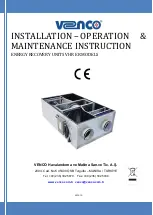
31 / 38
FR
EN
TF6203_A
7.4. CONDENSATION PUMP ALERT
See figure
31
A soft beep accompanies the display of this alarm.
This alarm is triggered when:
·The pump is not powered.
·The alarm of the condensation pump is not connected to the heat
recovery.
·The condensation pump is installed upside down.
·The water level detected by the pump is too high.
Check the proper operation of the condensation pump, with the help
of the maintenance manual specific to the condensation pump.
Press the “Return” icon to clear the alarm.
8.
POWERING DOWN AND RESET OF THE
INTERFACE
8.1. POWERING DOWN THE INTERFACE
The graphic interface is powered directly by the heat recovery unit. To
power down the interface, you can disconnect the RJ12 cable on the
back of the interface (See figure
32
).
Another solution is to power down the heat recovery unit.
Powering down the interface does not reset it. All of the settings
recorded during the initialization are preserved. The last settings
recorded on the user interface will be the default settings when the
interface is powered up.
Only the boost ventilation and free cooling modes need to be reactivated
after powering up.
8.2. RESETTING THE INTERFACE
To enter the initial settings of the graphic interface, the graphic
interface must be reset.
It is mendatory to replace the filters by new filters, fans
off, before performing the resetting of the interface.
The graphic interface is reset by a long press on the “Erase” button
(
A
). (See figure
33
).
After a few seconds, the screen turns black and returns to the
initialization phase described in 5: Initialization.
7.4. ALERTE POMPE À CONDENSATS
Voir figure
31
Un léger BIP sonore accompagne l’affichage de cette alarme.
Cette alarme se déclenche lorsque :
·La pompe n'est pas alimentée.
·L’alarme de la pompe à condensats n’est pas connectée au double flux.
·La pompe à condensats est installée avec la tête en bas.
·Le niveau d’eau détecté par la pompe est trop haut.
Vérifier le bon fonctionnement de la pompe à condensats, en
se munissant de la notice de maintenance propre à la pompe à
condensats.
Appuyer sur l’icône « Retour » afin de faire disparaître l’alarme.
8.
MISE HORS TENSION ET RÉINITIALISATION
DE L’INTERFACE
8.1. MISE HORS TENSION DE L’INTERFACE
L’interface graphique est directement alimentée par l'unité double
flux. Pour mettre l’interface hors tension, il est nécessaire de
débrancher le câble RJ12 au dos de l’interface (Voir figure
32
).
Une autre solution consiste également à mettre l'unité double flux hors
tension.
La mise hors tension de l’interface ne permet pas de réinitialiser
l’interface graphique. Tous les paramètres préenregistrés lors de
l’initialisation sont conservés en mémoire. Les derniers paramètres
enregistrés au niveau de l’interface utilisateurs seront également les
paramètres par défaut lors de la mise sous tension.
Seuls les modes de surventilation et de rafraîchissement devront être
réactivés après la mise sous tension.
8.2. RÉINITIALISATION DE L’INTERFACE
Pour renseigner les paramètres initiaux de l’interface graphique, il est
nécessaire d’effectuer une réinitialisation de l’interface graphique.
Il est obligatoire de remplacer les filtres usagés par des
filtres neufs, en mettant les ventilateurs hors tension,
avant d'effectuer la réinitialisation de l'interface.
La réinitialisation de l’interface graphique est provoquée par un appui
prolongé sur le bouton « Erase » (
A
). (Voir figure
33
).
Après quelques secondes, l’écran devient noir, et retourne à la phase
d’initialisation décrite au paragraphe 5 : Initialisation.







































